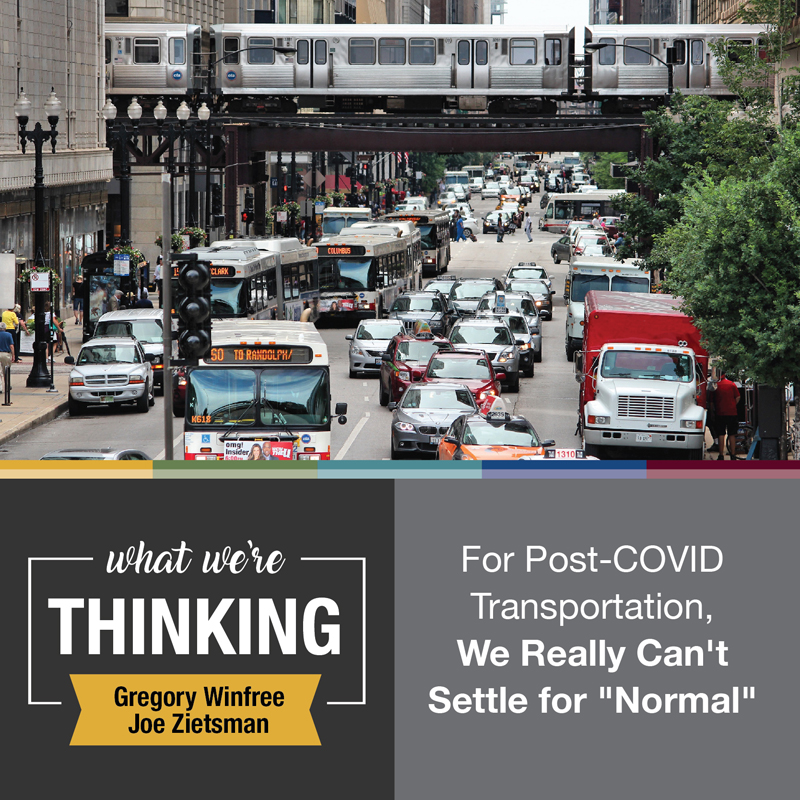 By Gregory Winfree and Joe Zietsman, Texas A&M Transportation Institute
By Gregory Winfree and Joe Zietsman, Texas A&M Transportation Institute
No sooner did America begin to crave a return to normal than did many of us start thinking that maybe normal wasn’t the best we could do. And that is certainly true when it comes to the issue of how best to move people and products from here to there in a post-COVID-19 world.
In fact, we’re already seeing ways in which our pandemic adjustments (or some variation of them) may need to stay with us well beyond a time when we let down our guard somewhat, even if we never fully return to what was familiar. Public transit, air travel, and daily commuting, as examples, have all been upended, producing varied results and implications. We’ll need to carry forward what we know is working, jettison what isn’t, and ask the right questions so we can tell one from the other.
We’re starting that process now at the Texas A&M Transportation Institute, focusing on nine considerations to help create a more resilient, sustainable, and socially equitable transportation system.
1. The spread of disease – The rapid worldwide advancement of the coronavirus demonstrates how transportation can be a disease vector, accelerating the transmission of a pathogen as a simple result of people traveling. How can we model the spread of a pandemic fueled by transportation and evaluate various policy options to control it?
2. Economic implications – Actions to stifle the spread of COVID-19 have had far-reaching consequences for states and cities that rely upon tax revenue to fund transportation infrastructure and services. Are there better ways to charge for and pay for those needs?
3. Travel demand – Shelter-in-place policies have shifted our work culture. To what extent might telecommuting become a new norm, and what might its impacts be on travel (both pro and con)?
4. Modal choices – The combination of social distancing and infection fears has slashed the use of public transit and ride hailing. What policies do we need to ensure that public transportation is reliable, affordable, and safe?
5. Land use and infrastructure – For decades, our road systems and city designs have been based in part on population density, a central factor in the spread of communicable diseases. What should a future transportation system look like to make it resilient, sustainable, and socially equitable to ensure ready access to critical needs and services during an outbreak?
6. Equity and environmental justice – A public health crisis can expose and magnify gaps among certain demographic sectors (such as the elderly, disabled, and poor), just as we often see with a natural disaster such as a hurricane. What equity and environmental justice issues have been highlighted by the current pandemic, and what role can transportation play to help address these societal disparities?
7. Resiliency and supply chains – In the wake of a natural disaster, we hope for transportation systems to bounce back to their original state. But to adequately support the functions of pandemic containment, response, and recovery, those systems need to be different – better than they used to be. What are the critical issues associated with supply chains in a public health emergency, and how can they be rectified to ensure a robust reaction?
8. Transportation innovation – Our ways of moving about have changed more in the past decade than in the previous century, and there remains still more room for improvement. How can public agencies, private-sector entrepreneurs and academia work together to advance and deliver new transportation discoveries?
9. Public health and sustainability – Transportation has many linkages with public health, including physical activity, vehicle crashes, and air pollution. How can we use this framework to equitably address the competing dimensions and needs of the economy, the environment, and society during a pandemic?
That’s a long list of priorities and questions, and there are more where those came from. But without exploring all of them thoroughly, we won’t have a clear path forward. We won’t know whether cleaner air and emptier freeways are momentary aberrations or evidence of newly entrenched ambitions.
This public health crisis will permanently reshape our behaviors in numerous ways. Consequently, our future transportation system will not – cannot – be a simple extension of its past. We need something better than the normal we were accustomed to. After all, it’s our modern transportation system that enabled the spread of the coronavirus in the first place. There’s clearly room for improvement in our post-modern approach to getting ourselves and our stuff from points A to B and beyond – safely, smoothly, and securely.
Gregory Winfree is the agency director of the Texas A&M Transportation Institute, a former U.S. assistant secretary of transportation and a board member of ITS America. Joe Zietsman is the director of the Center for Advancing Research in Transportation Emissions, Energy, and Health at the Texas A&M Transportation Institute.
This article was originally published in ITS America’s Momentum Newsletter, June 8, 2020.